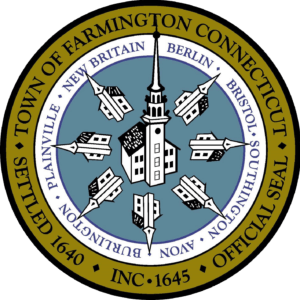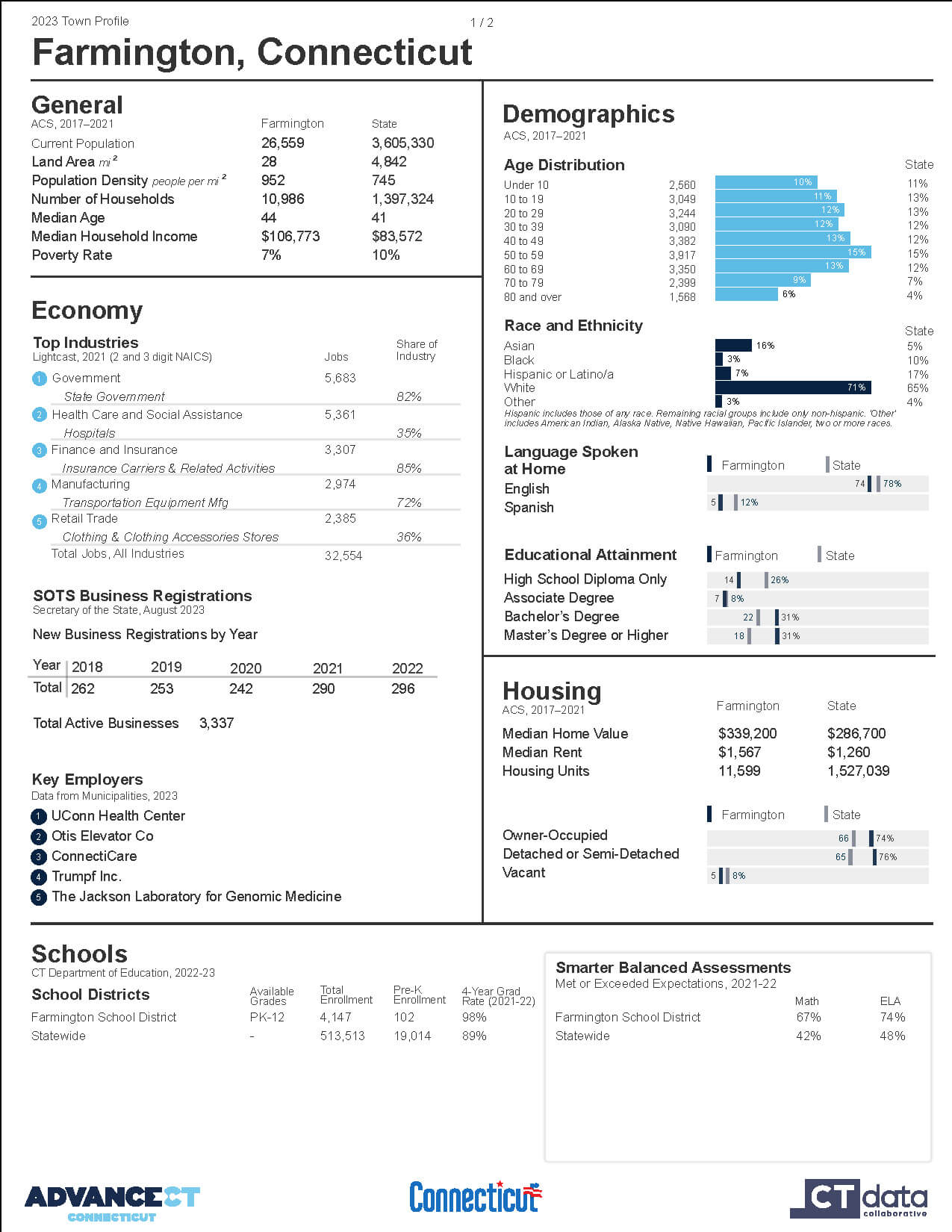Town of
Farmington

About Farmington
Farmington comprises 29 square miles along the Farmington River. It is a residential suburb of Hartford with a population of 26,500. The town has retained its distinctive character through maintenance of its historic districts and careful land use planning for the future. It currently has 11,500 housing units with a median sales price of $339,000 and a median household income of $106,773.
Farmington has a Council-Manager form of government with a Council Chairperson as the chief elected official and a Town Manager as the Chief Executive Officer. The vision of the Town of Farmington is that it will be recognized as a historic and progressive town with an engaged citizenry committed to the betterment of the entire community. To that end, high quality services are provided to a diverse population living and working in a balanced blend of open space, residential housing and commercial properties.
HISTORY
Farmington was incorporated in 1645 from what was known as Tunxis Plantation, one of the largest single land grants in the Colonies. Known as the “Mother Town,” Farmington was partitioned into the towns of Avon, Bristol, Plainville, New Britain, Berlin, Southington, and Burlington. This history is reflected in the Town Seal, which lists all of these towns.
BUSINESS CLIMATE
Farmington lies at the hub of major I-84 interchanges, giving it a strong advantage as a site for central Connecticut business and industry.
Farmington’s diverse grand-list allows for a commercial mill rate among the lowest in Connecticut. A stable, highly educated workforce, Blue Ribbon schools, low taxes and myriad recreational opportunities make the Town of Farmington an ideal place to do business.The University of Connecticut Health is the town’s largest employer with a staff of 5,000 and is a leading academic research institution in Connecticut. The Jackson Laboratory (JAX), built on a 17-acre site on the UConn Health campus, opened their 183,000 square foot facility in 2014. The JAX Genomic Medicine facility focuses on medical applications of genomics with academic and clinical partners from around the world.
TRUMPF, whose North American Headquarters is in Farmington, is the largest manufacturer of fabricating machinery in the U.S. Westfarms Mall is a major retail facility with more than160 stores and restaurants. Farmington is also home to over 2,000 small and mid-sized retail, service and manufacturing businesses that employ hundreds of workers.
EDUCATION
Farmington has a very strong school system and Farmington Public Schools demonstrate a continuing commitment to educational excellence. The Farmington Public School System is comprised of seven schools: four Elementary Schools to serve children in kindergarten through grade 4; West Woods Upper Elementary for students in grades 5 and 6; Irving A. Robbins Middle School for students in grades 7 and 8; and Farmington High School.
Farmington is also the home of Miss Porter’s, a world-renowned private school for girls in grades 9-12.Founded in 1843, the school currently has over 300 students from almost 30 different countries.
Farmington’s Public Schools are rooted in excellence, recognized as Blue Ribbon Schools by the U.S. Dept. Of Education. Newsweek Magazine has cited Farmington High School as one of the top 100 high schools in the country. Over 95% of Farmington graduates go on to college.
Farmington is also home to several distinguished higher learning institutions including, Tunxis Community College, University of Connecticut Health, Connecticut School of Broadcasting and Sanford-Brown College.
RECREATION
Hike or bike the scenic trails of the Farmington Valley Greenway, part of Farmington’s trail system created out of the abandoned Canal Railroad. These trails are paved for handicap accessibility with several entrances around town. Enjoy first class art and heritage at the Hill-Stead Museum featuring works by Monet, Manet, Degas, Cassatt, and Whistler. Situated on 152 acres, the museum also features a sunken garden, woodland trails, and a pond.
Visit Farmington’s other museums and historic sites: the Old Stone Schoolhouse, a museum of local history; theLewis Walpole Library, a research library for 18th-centurystudies; the Stanley-Whitman House, a house built in1720 preserving the local history of 18th century; and the Unionville Museum, preserving the history of Unionville. No matter what your interests are, Farmington provides numerous activities for both residents and visitors.

